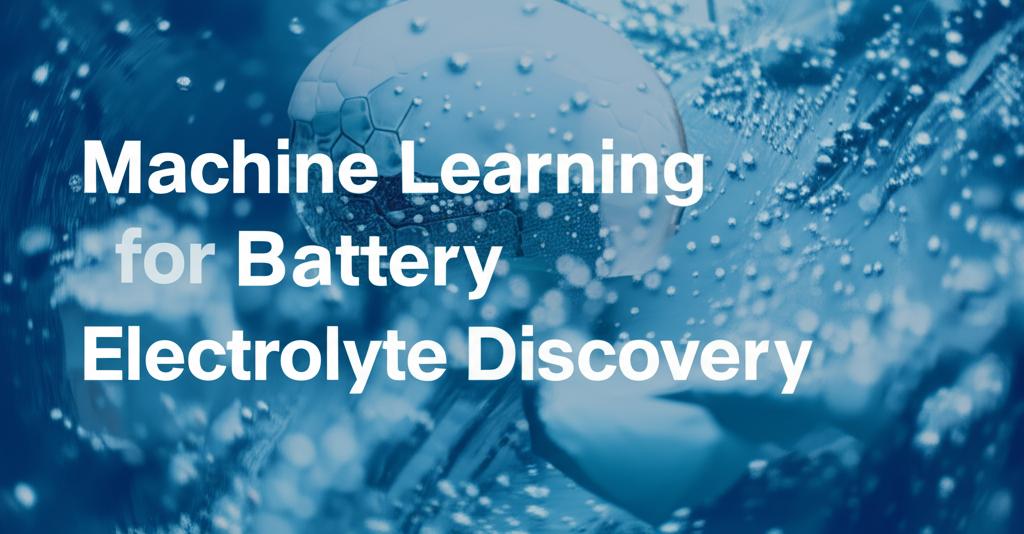The quest for better batteries is a major driver of technological advancement, particularly for electric vehicles, portable electronics, and grid-scale energy storage. Electrolytes, the crucial components that enable ion transport between a battery's electrodes, are a key focus of this research. Traditional methods of electrolyte discovery often rely on time-consuming and costly trial-and-error. However, machine learning (ML) and artificial intelligence (AI) are revolutionizing this field, offering a faster, more efficient path to identifying and optimizing new electrolyte materials.
Accelerating Discovery with Data-Driven ApproachesMachine learning algorithms can analyze vast datasets of existing materials and their properties to identify patterns and predict the performance of novel electrolyte candidates. This data-driven approach significantly speeds up the screening process compared to traditional experimental methods. Researchers are leveraging ML to:
- Predict Key Electrolyte Properties: ML models can forecast crucial characteristics like ionic conductivity, electrochemical stability (including oxidative and reductive stability), mechanical stability, and thermal stability. For example, high ionic conductivity is essential for efficient ion transport, while a wide electrochemical stability window is necessary for compatibility with high-voltage electrodes.
- Screen Vast Chemical Spaces: The number of potential molecules and material compositions for electrolytes is practically infinite. ML can rapidly sift through immense databases of candidates, including those from sources like the Inorganic Crystal Structure Database (ICSD), to pinpoint promising materials that experimentalists can then synthesize and test. This dramatically reduces the time and resources spent on unpromising leads.
- Optimize Material Compositions: ML can help fine-tune the composition of electrolytes, including the types of salts, solvents, and additives, to achieve a desired balance of properties. For instance, some models can predict how doping an electrolyte material will affect its ionic conductivity.
- Understand Structure-Property Relationships: By analyzing large datasets, ML can help researchers understand the complex relationships between a material's structure (at atomic and molecular levels) and its resulting electrolyte properties. This deeper understanding can guide the rational design of new materials.
- Solid-State Electrolytes (SSEs): A major focus is on developing SSEs for all-solid-state batteries (ASSBs). SSEs offer potential advantages in safety (non-flammability) and energy density. ML is instrumental in tackling challenges like low ionic conductivity and poor interfacial stability in SSEs. Researchers are using ML to screen for SSEs with high ionic conductivity, good mechanical properties to suppress dendrite growth (a common failure mechanism in lithium metal batteries), and stability against lithium metal anodes.
- Liquid Electrolytes: ML is also being applied to discover and optimize liquid electrolytes, particularly for lithium-ion batteries (LIBs) and next-generation systems like lithium-sulfur batteries. This includes identifying new solvent and salt combinations and optimizing additive packages.
- Polymer Electrolytes: For solid polymer electrolytes (SPEs), ML models are being developed to predict ionic conductivity based on molecular structure and composition. This helps in identifying polymers that can overcome the typically lower conductivity of SPEs compared to liquid or ceramic electrolytes.
- Supervised Learning: Algorithms like Random Forest, Support Vector Machines (SVM), Gradient Boosting (e.g., XGBoost, LightGBM), and neural networks are commonly used. These models learn from labeled datasets where material features are linked to known properties.
- Deep Learning: Deep learning models, including message passing neural networks (MPNNs) and graph convolutional neural networks (GCNNs), are increasingly used to learn representations of molecular structures directly. Generative models like Variational Autoencoders (VAEs) are being explored to design entirely new molecules with desired electrolyte properties.
- Integration with Computational Chemistry: ML is often combined with traditional computational methods like Density Functional Theory (DFT) and Molecular Dynamics (MD) simulations. ML can accelerate these computationally expensive simulations or learn from their outputs to build predictive models. DFT calculations provide data on properties like formation energies, band structures, and ion migration barriers, which can be used to train ML models.
- High-Throughput Screening: ML powers high-throughput virtual screening, allowing researchers to evaluate thousands or even millions of candidate materials computationally before selecting the most promising ones for experimental validation.
- Data Scarcity and Quality: The performance of ML models heavily relies on the availability of large, high-quality, and diverse datasets. Curating comprehensive and accurate experimental and computational data for electrolytes remains a challenge. Efforts are underway to build larger, more standardized databases.
- Descriptor Selection: Identifying the right "descriptors" or features that accurately represent the materials and correlate with their properties is crucial for building effective ML models. Developing universal descriptors that work across different material classes and properties is an ongoing research area.
- Interpretability (Explainable AI): Understanding why an ML model makes a certain prediction (explainability) is important for gaining scientific insights and building trust in the models.
- Generalizability: Ensuring that ML models can accurately predict properties for new, unseen materials and chemistries (generalization) is critical for their practical application in discovery.
- Inverse Design: A key goal is to develop ML models that can perform "inverse design" – starting from desired target properties and then predicting the material compositions and structures that would exhibit those properties.
- Automated Laboratories ("Self-Driving Labs"): Integrating ML with robotic experimentation platforms can create autonomous systems that can design, synthesize, test, and learn from new materials in a closed loop, further accelerating the discovery process.
- Multi-Property Optimization: Electrolytes need to satisfy multiple performance criteria simultaneously (e.g., high conductivity, good stability, safety). Developing ML frameworks that can effectively optimize for several, often conflicting, properties is essential. New metrics, like the "eScore" which balances ionic conductivity, oxidative stability, and Coulombic efficiency, are being developed for this purpose.
As of early 2025, the field is rapidly advancing. Researchers are creating more sophisticated ML models, compiling larger and more diverse datasets, and integrating AI more deeply into the experimental workflow. The synergy between AI, computational modeling, and experimental validation holds immense promise for overcoming the bottlenecks in traditional electrolyte R&D and paving the way for the next generation of high-performance, safe, and cost-effective batteries.

